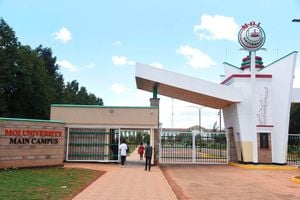Digital tools help cut malaria cases in Busia as CHPs take charge

Community Health Promoter, Everline Sisuma (right) uses her digital device to register the household of Claudia Samatha during her household registration exercise in Nambale, Busia County
What you need to know:
The latest report by the Kenya Medical Research Institute (Kemri) reveals that digital tools have been key in increasing access to malaria testing and treatment services.
Until 2017, Ms Joyce Oduor, a resident of Nambale, Busia County, would make at least two trips to the Busia County Referral Hospital every month in search of malaria treatment services.
The hospital located more than five kilometres away from her village was the only place Ms Oduor could access treatment services for the parasitic disease.
While her family would sleep under a treated mosquito net, Ms Oduor’s two children under the age of five would still contract the parasitic disease. To get to the hospital, the mother of three says she would be forced to part with at least Sh200 to facilitate their road transport to the health facility.
When unable to raise the transport fee, the mother would resort to over-the-counter drugs or rely on painkillers.
“The long queues at the hospital were one of the reasons why I avoided the health facility. I made a habit of only travelling to the hospital whenever my children’s conditions deteriorated,” says Ms Oduor adding that on most occasions, the children would be hospitalized for days.
In 2017 however, the county in partnership with Living Goods, a non-government organisation rolled out a programme aimed at equipping the Community Health Promoters (CHP) with digital tools.
The programme saw the CHPs supplied with smartphones, and health commodities used in the diagnosis and treatment of malaria among other health conditions affecting children under the age of five.
“The CHPs have helped in managing malaria in my household, my last born son, now aged two years, has been a major beneficiary of the household malaria diagnosis and treatment,” says Ms Oduor.
The latest report by the Kenya Medical Research Institute (Kemri) has now revealed that digital tools have been key in increasing access to malaria testing and treatment services.
According to Dr Elizabeth Echoka, a senior Principal Research Scientist at Kemri, 75 per cent of the children under the age of five in Busia County can comfortably use malaria testing services.
The Kemri report revealed that as of 2017 when the digitisation project kicked off in the malaria-prone county, only 51 per cent of the population were accessing malaria testing services.
The research conducted between 2017 to 2023 has also revealed that digitisation of community health services led to an increase in same-day diagnosis and treatment of malaria from 9 per cent to 59 per cent.
“By taking on more responsibility for testing, the CHPs reduced the load on health facilities and made it easier for people to get diagnosed and treated within their communities,” said Dr Echoka.
It focused on the management of malaria, diarrhoea, and pneumonia in the Nambale sub-county while assessing the number of children who received diagnosis and treatment of the health conditions.
Further, it sought to find out how quickly clients would access health services in hospitals and the role of CHPs in disease management. The health workers were trained to use smartphones with helpful tools like interactive guides, digital records and learning modules.
“These digital tools allowed the CHPs to provide faster and better care, making them the first line of defence in the community. The initiative offered a lifeline to children suffering from common yet deadly illnesses,” said Dr Echoka.
The health workers would conduct household visits and with the help of a guide on the smartphone application, could diagnose and treat malaria cases.
The CHPs were also trained in malaria drug administration. After treatment, the health workers would be required to make regular visits to the patients to check on their recuperation progress.
The patients whose conditions deteriorated within 24 hours of drug administration would be referred to the nearest health facility for further treatment.
“Through the integrated community case management (iCCM), the community-based healthcare workers have been delivering treatment interventions closer to caregivers and sick children and reducing the need for travel to distant healthcare facilities,” said Mr Thomas Onyango, Country- Director of Living Goods.
He added: “The research has found evidence that data and technology-powered community-based healthcare improves treatment coverage for the top causes of child mortality: acute respiratory infections (ARI), diarrhoea, and malaria,”.
According to Mr Emmanuel Luvai, the Busia County Community Health Services Focal person, CHPs in the county are currently managing half of the workload of malaria cases.
The CHPs, he said, handle 50 per cent of the malaria cases at the household level and have seen a reduction in queues at the health facilities.
“Empowering the CHPs to deliver high-quality care at the community level by providing the right tools can save many lives. We are moving closer to a world where every child, no matter where they live, can get the care they need to stay healthy and grow. “said Mr Onyango.



